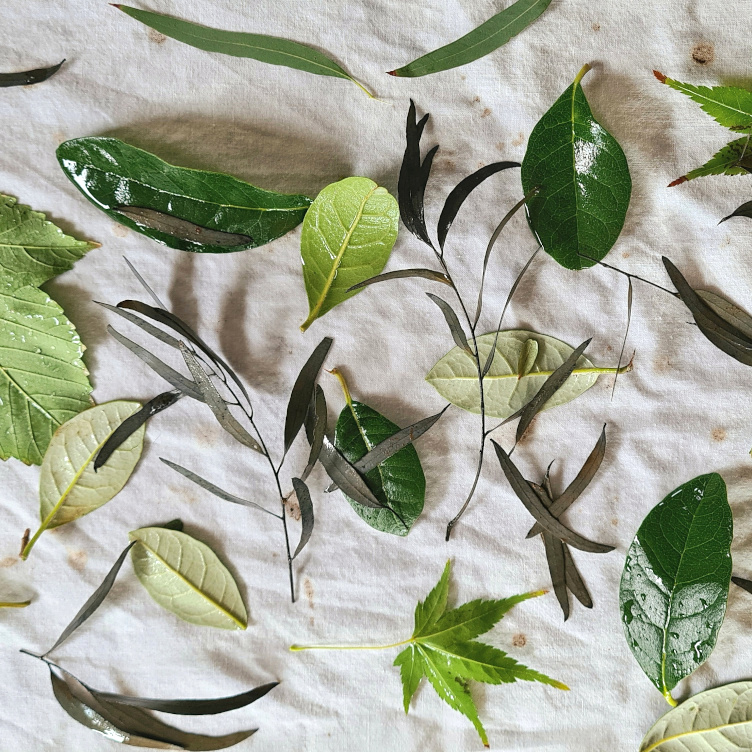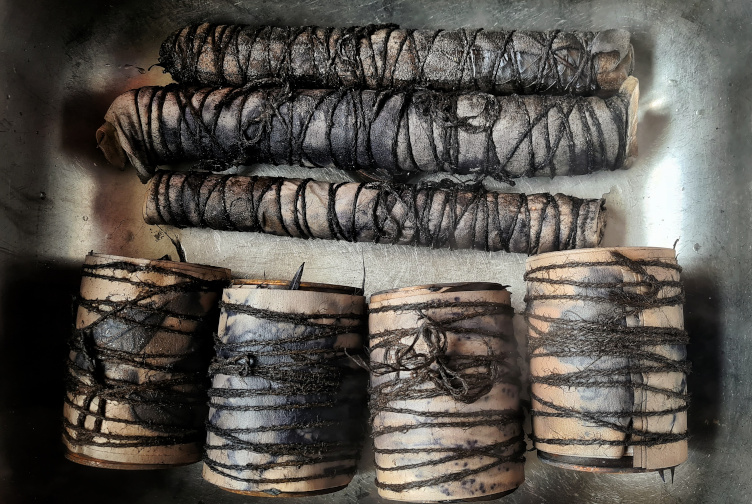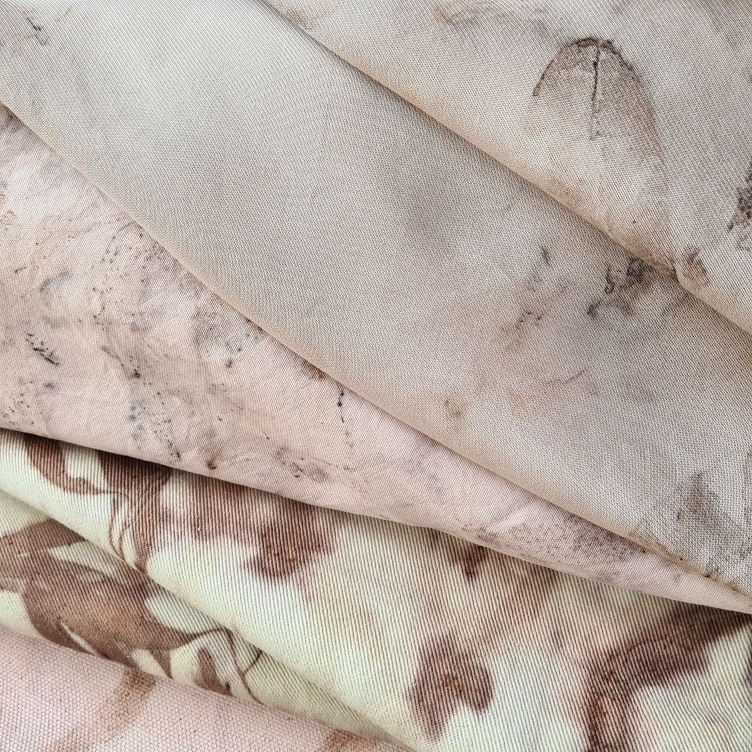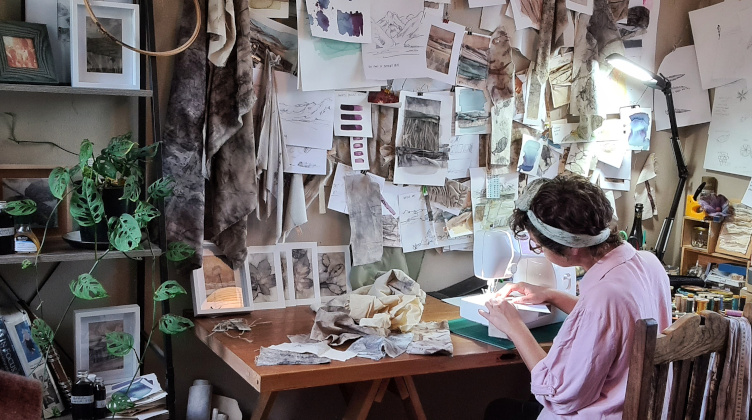Inspired by the green spaces of Ōtautahi Christchurch, Seonaid Burnie of The Clothworks looks at closing the loop when it comes to the art on our walls by re-purposing second-hand fabrics, employing eco-printing and dyeing techniques using plants and trees foraged from our City’s residential red zone, and bringing a little bit of the Garden City back into our homes.


What do you make?
I re-purpose second-hand fabric with eco-print and dye techniques, using flora foraged from Christchurch’s residential red zone, to create unique pieces of textile art. Transferring the tannins and pigments from leaves on to fabric creates unique colours and textures that when manipulated and layered, portray the beautiful and varied landscapes of Aotearoa.
How did you get into your craft?
After moving to a new house close to the Christchurch residential red zone four years ago, I found that this vast area, which was once was home to much loved home and gardens, had turned from rubble and ruin in the wake of the earthquakes to an oasis of abundant flora and fauna. I walk through the red zone most days, so out of sheer inquisitiveness began my journey of exploration into the plants and trees growing there and how they could be utilised. I had heard of eco-printing before but never tried it and I have to admit the initial results were not necessarily that impressive, but the colours and textures that were created using the process were so beautiful to me. I started by making bags and cushions, printing clothes. One day I remember looking at a bit of my printed fabric; the marks on it looked like clouds, almost like a painting, and that’s really where my textile landscapes started: patching and layering together fabric to create the scenes in my mind. A trip to the beach, driving around Waipara, walking around the Port Hills, places that have been etched into my memories, places that inspire me.


Do you have formal training or qualifications in your craft?
I studied textile design back in Scotland (where I am from originally) specialising in print using silk screens. Although this is a different sort of printing altogether, I guess the basic concept is the same. I have developed my process by experimenting lots, researching and learning where I can from the amazing eco-printing and textile community.
Your favourite materials, tools and processes?
The whole process of eco-printing never fails to completely captivate and surprise me. Each time I go to unwrap a bundle, I get so excited, giddy like a little kid to see what the results are. Also, the process of pulling off the leaves to see the print underneath is seriously therapeutic.
I love working with fabric, especially ones that drape and fall elegantly. Using solely second-hand, I don’t see silk very much but when I do find it, it is such a joy to handle, it yields such vibrant colours and prints.
Tell us about some of the techniques involved in producing one of your pieces
Eco-printing is a process of transferring the tannins and pigments from leaves, by heat, on to fabric. This is done is by placing the leaves on fabric and rolling or folding them into ‘bundles’ before steaming or boiling them. There are so many factors involved in eco-printing, from the type of fabric, types of leaves (results even varying from tree to tree), mordant type (something to fix the print to the fabric), length of heat time, bundle techniques… the list goes on! I’m still learning, but it is such a magical and varied process, I don’t think I’ll ever stop.
All of my printed/dyed fabrics go in to my studio where I spend a lot of time rifling through them to find the right ones to piece together the scenes in my head or from photographs. I love the way that fabrics fold and twist – there is so much beauty in just a bit of fabric moving in a certain way. I use my trusty wee sewing machine to patch them all together – she’s a very basic little pink Brother, but she gets the job done.



What inspires you?
This beautiful place we get to call home. I feel so lucky to live in this Garden City, to be surrounded by our green spaces, inspiring scenery and creative communities. In particular the residential red zone, where my eco-printing journey began, is such a special place – full of history and memory and life.
Is there a philosophy behind your work?
I guess the guiding principle behind The Clothworks is really the ability to create affordable and original art that people want to hang on their walls, without the carbon footprint – closing the loop, using what is already out in the world along with Mother Nature to inspire us. My process is not perfect, but I’m trying everyday to improve what I do and how I do it, so it has the least impact on our environment.
Describe your creative process:
There’s four parts to it really: the first is sourcing fabric, finding pre-loved items in the op shops that are made from natural fibres. With the emergence of fast fashion and cheap synthetic materials, this can be harder than you think! The second is foraging for leaves/berries, seeing what’s in season – what can I use to create colour, texture, pattern? The third is the printing dyeing process – preparing the fabric, applying heat, and then unbundling to see the results and cleaning. The final part is piecing together and manipulating the fabrics, using their folds and prints to create an abstract image, sometimes using inspiration from memory and sometimes from photographs. I also love embellishing them a bit with stitch and loose thread to add in extra texture and movement.



Describe your workspace:
My creative sanctuary: a small room at the back of my house which is crammed with fabric, scribbles and experiments flung up the walls. It does expand to the kitchen on printing days and occasionally the dining table and spare room too… I think most creative people who work from home can relate!
Five words that describe your mind:
A creative easily distracted jumble!
Your favourite feedback from a customer:
Nothing specific comes to mind, people are so lovely in general, but I guess I just enjoy when I show people what I do and they realise how magical the eco-printing process is – people are so in awe that a humble little leaf or berry can make these beautiful marks and colours.
What are you reading now?
I literally have about ten books on my bedside table. (Like I said, I am easily distracted and like to have lots of things on the go!) Among them is ‘Making Ink’ by Jason Logan (a wee hint at what I’m getting up to as Autumn sets in), ‘Chromatopia’ by David Coles – a fascinating read about the history of colour. And I also was gifted ‘Girl, Woman, Other’ by Bernardine Evaristo by a friend, which I’ve just started.
A favourite quote:
“Art is not what you see, but what you make others see.” Edgar Degas.


Tell us about your pets:
I have two dogs that keep me company in the studio and on my walks around the red zone to forage, they’re always up to mischief and tend to feature a lot in my social media stories, mostly for comedy value. I also have a cat who is a bit quirky, who generally likes to wind up the dogs and attempt to sleep on all my fabric.
If you were a crafty superhero, what would your name and superpower be?
Hmmm, not sure… something related to planting trees and flowers in our green spaces, or maybe turning all the rubbish we create into plants? I don’t know that’s a hard question! Either way, I reckon I could eco-print myself up a pretty cool cape…
What was the last handmade item you bought and what attracted you to it?
I treated myself to a beautiful pair of KJD Jewellery earrings, they are textured copper but also lightweight, so perfect for my ear lobes (which don’t enjoy heavy loads!).
What would your advice be for those starting out in a crafty business?
I don’t really feel like I’m at the stage where I can give advice just yet(!) but I guess if I had to say anything, it would be to keep going, persevere doing what you love. There are people out there who love what you do, they just need time to find you. It’s an emotional rollercoaster but so worth it when someone compliments, shares or buys your work.
Also, I could not recommend enough getting yourself immersed in, and connecting with your creative community – the support of collectives like Greenlane, Nest, The Kowhai Collective and Arts Canterbury for me has been so important, not just for finding a platform for my work but also gaining confidence through their encouragement and direction.



Why do you think it’s important to buy handmade and/or locally made goods?
There are so many reasons! Supporting your local creatives nurtures communities, keeps skills and traditions alive, reduces your carbon footprint, speaks of ‘your place’, inspires others, to name just a few. When you buy handmade, you are supporting someone’s passion, something they have poured a piece of themselves into. It takes a lot of courage to put yourself out there and when someone buys something from you, it not only helps to put food on the table but it supports your ability (and your confidence) to create again and again.
What does it mean to you when someone buys your creations?
It fills me with so much gratitude, that someone would want to spend their hard-earned money on one of my creations. It really is the biggest form of flattery.
What’s in store for 2021?
Lots of exciting stuff – some cool collaborations in my local community, lots of new experiments and my very first solo exhibition! My Upcoming events include the – Greenlane Markets (held once a month), the Christchurch Art Show (with Arts Canterbury) on the 8–11 April, and a solo exhibition, Arthole at the Darkroom, opening on 12 October.
Special offer for Felt readers!
Seonaid is generously offering a 25% discount on anything in her Felt shop for the duration of her feature fortnight! That’s right, you can get 25% off any of her stunning art pieces until 5pm, Monday 12 April. To secure this great discount make sure to enter the voucher code theclothworks25 in the voucher code field on page four of checkout when you purchase. Thank you so much Seonaid!
See more from The Clothworks here »







The amount of hard work and passion is priceless. Great work!
Your creations are beautiful!
These are stunning! I’m fascinated by the eco-dying process and this is such an original use of the resulting fabric.
Such kind words, thank you so much Kate!